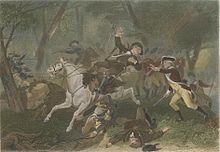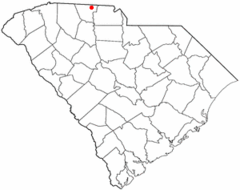Battle of Kings Mountain
The Battle of Kings Mountain on October 7, 1780 was a major colonial victory during the American Revolutionary War . The settlers' troops overwhelmed the armed forces loyal to the king , led by the British Major Patrick Ferguson . In the book The Winning of the West , Theodore Roosevelt described the battle of Kings Mountain as "the turning point of the American Revolution".
prehistory
The troops of the colonists were made up entirely of volunteers who were among the men who had picked himself: William Campbell , John Sevier , Frederick Hambright , Joseph McDowell , Benjamin Cleveland , James Williams , John McKissack and Isaac Shelby led the Supreme their Troops, while Captains Joseph Winston and Edward Lacey commanded the other mostly autonomous groups.
After Horatio Gates' army was defeated at the Battle of Camden , British General Charles Cornwallis believed that the provinces of Georgia and South Carolina were under British control and he began planning the invasion of North Carolina. But the South Carolina Civil War continued.
The Whigs- close frontier population carried out raids on the loyal British outposts under some self-appointed colonels (Isaac Shelby, Elijah Clarke and Charles McDowell). To protect the western flank, Cornwallis handed over the leadership of the militia loyal to the king to Major Patrick Ferguson. He himself led the invasion of North Carolina on September 9, 1780 and reached Charlotte on September 26. Ferguson followed and set up a base camp at Gilbertown and urged the colonists to lay down their arms, or else he threatened them to devastate the country. The harshly worded message piqued the residents of the Appalachian border region and they gathered at Sycamore Shoals and decided to bring the war to Ferguson instead of waiting for it. Since the settlers west of the Smokey Mountains were called Overmountain People , the volunteers were nicknamed Overmountain Men .
Through a captured deserter , Ferguson learned of the approaching settlers and retreated east to join the main Cornish forces at Charleston, but decided to face the pursuers at Kings Mountain .
Forces involved
With the exception of Major Ferguson, all participants in the battle came from the colonies, his troops were composed exclusively of teams loyal to the king, and he commanded a total of 1,000 men. The colonist troops facing him, about 900 men, were also under the command of patriotic officers . There was not enough supplies or supplies for either side.
Unlike most other British officers, Ferguson believed that the colonial forces could well be as efficient as the regular British military. Years earlier, Ferguson had designed, patented and field tested a musket ( breech loader ) which he called the Ferguson rifle and which could fire with greater precision and speed than the then common Brown-Bess , a muzzle loader used by the British Army . More importantly, the soldier did not have to stand up and offer himself to the enemy as a target to load the weapon. Ferguson had armed an 80-man unit and led it into battle at Brandywine . Despite its efficiency, the British military authorities refused to introduce the weapon, fearing a change in the traditional way of waging war. Embittered by this experience, Ferguson tried everything to prove at least his second theory and drilled his men hard but with feeling. He created a very tightly woven and very disciplined unit and was eager to see it deployed against the revolutionaries. Ferguson was killed by the Overmountain Men during the battle.
Course of the battle
The battle began on October 7, 1780, when 900 militia members from the area west of the colonies (including John Crockett, Davy Crockett's father ) reached the steep base of the Kings Mountains at dusk. They formed eight groups of 100 to 200 men each. Two of the groups, led by John Sevier and William Campbell, attacked the highest but narrowest part of the wooded hill, while the other troops, led by Colonels Shelby, Williams, Lacey, Cleveland, Hambright, Winston, and McDowell, attacked the main royal contingent by circling the mountain at the lowest point.
The revolutionaries crawled up the hill and fired from cover at the red coats, Ferguson rallied his troops and ordered a bayonet attack against the men of Campbell and Sevier. Even without bayonets, the Overmountain Men retreated into the forest at the foot of the hill, still firing. Ferguson ordered two more bayonet attacks, during one of which Colonel Williams was killed and Colonel McDowell wounded. But after each attack, the revolutionaries kept returning to the bottom of the hill firing. It was difficult to find targets for the troops loyal to the king, as the border residents were constantly on the move and, similar to today's tactics, kept themselves constantly hidden and under cover .
After several hours of fighting, the losses of the loyal British troops were high. Ferguson kept riding up the hill, whistling orders on his silver whistle. When he was slowly becoming desperate, he pulled a plaid shirt over his red uniform jacket. A soldier discovered this and alerted his comrades. At the height of the battle, when the Patriots overran the Loyalists, Ferguson fell fatally from the saddle. Eight bullets were in his body.
When the redcoats saw their leader fall, they lost their courage and surrendered, but the revolutionaries, enraged by the Waxhaw massacre and others, kept firing as they shouted, "Give them Tarleton quarters " ( quarters here means prisoner of war ) . Only after a few minutes did the colonels get the situation under control and arrested 700 men loyal to the king.
Consequences of the battle
The actual battle of Kings Mountain lasted only 65 minutes, 225 men fell on the British side, 163 were wounded and 716 were captured. On the side of the Patriots, 28 were killed and 62 men wounded. The redcoats caught were rounded up, if they could still walk, and taken to camps a few kilometers away; the dead and wounded were left on the battlefield. Another nine royalists were hanged for switching sides, other sources say the Tories have been tried for war crimes. Those hanged afterwards were charged with crimes such as looting. With the defeat as evidence of the fierce resistance he had to face, Cornwallis abandoned his plan to invade North Carolina and retreated south.
After the battle, Joseph Greer of the Watauga Association at Sycamore Shoals (near present-day Elisabethton , Tennessee ) made the 950-kilometer trip to Philadelphia to inform the colonial government of the British defeat. He reached his destination on November 7, 1780.
In 1931, the United States Congress established the Kings Mountain National Military Park not far from the Kings Pinnacle on the battlefield. The park's visitor center is located in Blacksburg , South Carolina and welcomes hundreds of thousands of visitors each year.
Individual evidence
- ↑ Map of the battle
- ^ The Battle of King's Mountain
- ^ Greer's report of the American Patriot victory at Kings Mountain "re-energized a downtrodden Continental Congress."
Web links
- Official website of the National Park
- Sycamore Shoals State Park - Tennessee Park Service
- Roan Mountain Tennessee Citizens Club: Overmountain Men Celebration
- Georgia Georgia Society, Sons of the American Revolution: Participants at Kings Mountain
Coordinates: 35 ° 7 ′ 9.7 ″ N , 81 ° 23 ′ 36.9 ″ W.

